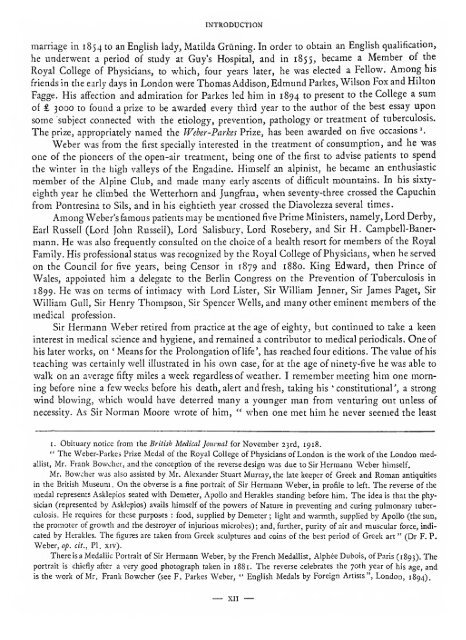The Weber collection; Greek coins ... - Forvm Ancient Coins
The Weber collection; Greek coins ... - Forvm Ancient Coins
The Weber collection; Greek coins ... - Forvm Ancient Coins
You also want an ePaper? Increase the reach of your titles
YUMPU automatically turns print PDFs into web optimized ePapers that Google loves.
INTRODUCTION<br />
marriage in 1854 to an English lady, Matilda Griining. In order to obtain an English qualification,<br />
he underwent a period of study at Guy's Hospital, and in 1855, became a Member of the<br />
Royal College of Physicians, to which, four years later, he was elected a Fellow. Among his<br />
friends in the early days in London were Thomas Addison, Edmund Parkes, Wilson Fox and Hilton<br />
Fagge. His affection and admiration for Parkes led him in 1894 to present to the College a sum<br />
of € 3000 to found a prize to be awarded every third year to the author of the best essay upon<br />
some subject connected with the etiology, prevention, pathology or treatment of tuberculosis.<br />
<strong>The</strong> prize, appropriately named the <strong>Weber</strong>-Parkes Prize, has been awarded on five occasions \<br />
<strong>Weber</strong> was from the first specially interested in the treatment of consumption, and he was<br />
one of the pioneers of the open-air treatment, being one of the first to advise patients to spend<br />
the winter in the high valleys of the Engadine. Himself an alpinist, he became an enthusiastic<br />
member of the Alpine Club, and made many early ascents of difficult mountains. In his sixty-<br />
eighth year he climbed the Wetterhorn and Jungfrau, when seventy-three crossed the Capuchin<br />
from Pontresina to Sils, and in his eightieth year crossed the Diavolezza several times.<br />
Among <strong>Weber</strong>'s famous patients may be mentioned five Prime Ministers, namely, Lord Derby,<br />
Earl Russell (Lord John Russell), Lord Salisbury, Lord Rosebery, and Sir H. Campbell-Baner-<br />
mann. He was also frequently consulted on the choice of a health resort for members of the Royal<br />
Family. His professional status was recognized by the Royal College of Physicians, when he served<br />
on the Council for five years, being Censor in 1879 and 1880. King Edward, then Prince of<br />
Wales, appointed him a delegate to the Berlin Congress on the Prevention of Tuberculosis in<br />
1899. He was on terms of intimacy with Lord Lister, Sir William Jenner, Sir James Paget, Sir<br />
William Gull, Sir Henry Thompson, Sir Spencer Wells, and many other eminent members of the<br />
medical profession.<br />
Sir Hermann <strong>Weber</strong> retired from practice at the age of eighty, but continued to take a keen<br />
interest in medical science and hygiene, and remained a contributor to medical periodicals. One of<br />
his later works, on ' Means for the Prolongation of life', has reached four editions. <strong>The</strong> value of his<br />
teaching was certainly well illustrated in his own case, for at the age of ninety-five he was able to<br />
walk on an average fifty miles a week regardless of weather. I remember meeting him one morn-<br />
ing before nine a few weeks before his death, alert and fresh, taking his 'constitutional', a strong<br />
wind blowing, which would have deterred many a younger man from venturing out unless of<br />
necessity. As Sir Norman Moore wrote of him, " when one met him he never seemed the least<br />
I. Obituary notice from the British Medical Journal for November 23rd, 1918.<br />
'•' <strong>The</strong> <strong>Weber</strong>-Parkes Prize Medal of the Royal College of Physicians of London is the work of the London med-<br />
allist, Mr. Frank Bowcher, and the conception of the reverse design was due to Sir Hermann <strong>Weber</strong> himself.<br />
Mr. Bowcher was also assisted by Mr. Alexander Stuart Murray, the late keeper of <strong>Greek</strong> and Roman antiquities<br />
in the British Museum . On<br />
the obverse is a fine portrait of Sir Hermann <strong>Weber</strong>, in profile to left. <strong>The</strong> reverse of the<br />
medal represents Asklepios seated with Demeter, Apollo and Herakles standing before him. <strong>The</strong> idea is that the phy-<br />
sician (represented by Asklepios) avails himself of the powers of Nature in preventing and curing pulmonary tuber-<br />
culosis. He requires for these purposes : food, supplied by Demeter ; light and warmth, supplied by Apollo (the sun,<br />
the promoter of growth and the destroyer of injurious microbes); and, further, purity of air and muscular force, indi-<br />
cated by Herakles. <strong>The</strong> figures are taken from <strong>Greek</strong> sculptures and <strong>coins</strong> of the best period of <strong>Greek</strong> art " (Dr F. P.<br />
<strong>Weber</strong>, op. cit., PI. xiv).<br />
<strong>The</strong>re isa Medallic Portrait of Sir Hermann <strong>Weber</strong>, by the French Medallist, Alphee Dubois, of Paris (1893). <strong>The</strong><br />
portrait is chiefly after a very good photograph taken in 1881. <strong>The</strong> reverse celebrates the 70th year of his age, and<br />
is the work of Mr. Frank Bowcher (see F. Parkes <strong>Weber</strong>, " English Medals by Foreign Artists", London, 1894).<br />
XII —

















